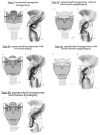Open Partial Laryngectomies: History of Laryngeal Cancer Surgery
- PMID: 36142999
- PMCID: PMC9501694
- DOI: 10.3390/jcm11185352
Open Partial Laryngectomies: History of Laryngeal Cancer Surgery
Abstract
Historically, surgery was the first-choice therapy for early, intermediate and advanced laryngeal squamous cell carcinoma (LSCC). Partial laryngeal surgery has evolved in recent decades and was influenced by many historic events and the development of new technologies. Partial laryngectomies may be performed by open, endoscopic or transoral robotic approaches. In this historic paper, we describe the evolution of open partial laryngectomy techniques, indications and surgical outcomes. Since the first partial laryngectomy in 1788, many U.S., U.K. and European surgeons, including Henry Sands, Jacob da Silva Solis-Cohen and Theodor Billroth, performed this surgical procedure under local anesthesia for tuberculosis, cancer or syphilis. Partial laryngectomy gained reputation in the medical community in 1888 due to the laryngeal cancer and death of the prince of Prussia, Frederick III. Frederick III's death represented the turning point in the history of partial laryngectomies, calling attention to the importance of semiotics, biopsy and early diagnosis in laryngeal cancers. Hemi-laryngectomy was indicated/proposed for lateral laryngeal tumors, while thyrotomy was indicated for cancers of the middle part of the vocal fold. The second landmark in the history of partial laryngectomies was the discovery of cocaine, novocaine and adrenaline and the related development of local anesthetic techniques, which, together with the epidemiological and hygienic advances of the 19th century, allowed for better perioperative outcomes. General anesthesia was introduced in the second part of the 20th century and further improved the surgical outcomes. The diagnosis of laryngeal cancer was improved with the development of X-rays and direct laryngoscopies. The 20th century was characterized by the development and improvement of vertical partial laryngectomy procedures and the development of horizontal partial laryngectomies for both supraglottic and glottic regions. The history and the evolution of these techniques are discussed in the present historical paper.
Keywords: cancer; head neck; history; laryngeal; larynx; otolaryngology; partial laryngectomy; surgery.
Conflict of interest statement
The authors declare no conflict of interest.
Figures




References
-
- Global Burden of Disease Cancer Collaboration Global, Regional, and National Cancer Incidence, Mortality, Years of Life Lost, Years Lived with Disability, and Disability-Adjusted Life-Years for 29 Cancer Groups, 1990 to 2017: A Systematic Analysis for the Global Burden of Disease Study. JAMA Oncol. 2019;5:1749–1768. - PMC - PubMed
-
- Succo G., Peretti G., Piazza C., Remacle M., Eckel H.E., Chevalier D., Simo R., Hantzakos A.G., Rizzotto G., Lucioni M., et al. Open partial horizontal laryngectomies: A proposal for classification by the working committee on nomenclature of the European Laryngological Society. Eur. Arch. Otorhinolaryngol. 2014;271:2489–2496. doi: 10.1007/s00405-014-3024-4. - DOI - PubMed
-
- Silver C.E. Survey for Cancer of the Larynx and Related Structures. Churchill Livingstone; New York, NY, USA: 1981.
Publication types
LinkOut - more resources
Full Text Sources

